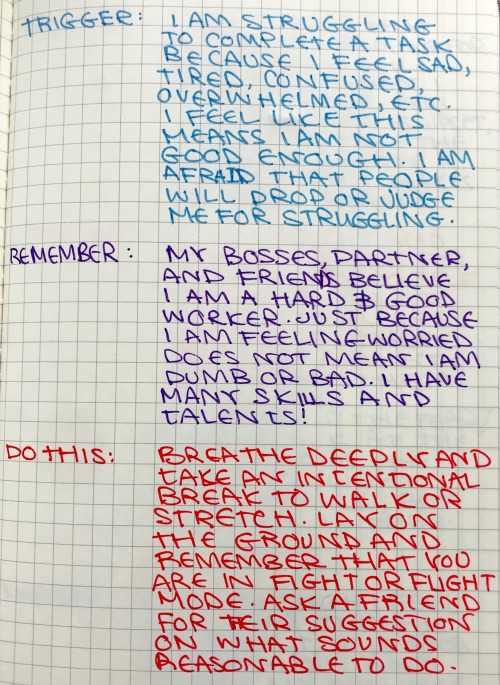For me, Negative Self Talk usually sounds like this: Why would anyone like me? I’ll never be good enough. I shouldn’t even try. I’m going to fail anyways.
It feels cringingly horrible, and once I fall into the dark pit of a self loathing loop it can be very difficult to pull myself back out. Let’s take last week as an example: I knew that I had an array of tools that might help me to feel better, but pain and hyperarousal made accessing them feel like an insurmountable task.
As I draft this post, I feel pretty good. My pain is liminal, I’m sitting by an open window with a warm breeze blowing through, and I’m working from home with a snoozing puppy in the other room. Unlike last week, I’m in my wise mind and I feel calm and present. With that awareness, I’ve created a toolkit of 7 coping tools I can easily access and apply when negative self talk hits. And I want to share it with you!
One of the key diagnostics of Complex PTSD is that a traumatic experience was chronic. I survived my chronic traumas by developing an extremely high tolerance to repeated distress, and so I spent more time in states of shame and fear than I did in joy or love. I used negative self talk as way to cope and survive: If I believed that my inherent being was the reason I experienced repeated traumas, then I could grasp at least some sort of explanation when the negative experiences happened again and again.
Fast forward a whole bunch of time, therapy, and hard work. I have learned how to exist without many of the maladaptive coping mechanisms that got me through the dark times. I’m committed to continual self development. However, despite my dedication to healing, I still need practice when it comes to negative self talk. The following 7 tips will serve as a toolkit or “cheat sheet” to help me develop healthy habits in place of negative self talk.
1. Breathe
This one sounds so simple, but if you’re worked up it can be hard to remember to breathe! Intentional breathing can calm our nervous systems, and it helps me to feel more grounded when I’m spinning out. I like to use the following gif as a guide to breathing, but a search for “breathing gif” can bring up more examples.

2. What to Do If You’re Having a Flashback
People with PTSD and CPTSD experience different types of flashbacks. I have emotional flashbacks. While they sometimes catch me by surprise, I have learned to predict when one is coming on. When I get those first feelings of hypervigilence, I turn to Paul Walker’s “13 Steps for Managing Flashbacks” (pdf version here). I wrote each step down on note cards so I can access them when I need them, but you could even screenshot the list and carry it in your phone. I also imagine these steps might be helpful to people who are having anxiety or panic attacks.
3. Meditate
I mentioned meditation during my Movement week. Here are a few meditations I turn to when I’m feeling hopeless, broken, or triggered.
Sarah Blondin’s Live Awake. Truly any of them help, but “self love” is a good target for negative self talk. The actual meditations don’t start until about halfway through, but Blondin’s voice is so incredibly peaceful and her message is completely soothing and empowering, so I treat the whole things as a meditation.
Lisa A. Romano’s guided meditations. Many of these focus on healing the inner child. This one in particular breaks me down and builds me back up, but I’ve found all of her meditations to be enlightening when I feel caught in the muck of old trauma.
4. Emotional Freedom Technique
I mentioned this is my Focus week. My therapist taught me about EFT (also called tapping) because I was having a hard time trusting that I could both experience bad feelings and still feel hopeful. If you’d like a “how to” to EFT, I think this one is pretty good.
But, if you’re already feeling anxious and want some help, I’d encourage you to check out Abiola Abrams’s “Guided EFT For Obsessive Worry, Anxiety, and Feeling Afraid” (start around 2:30). I love how she slowly moves from the negative thought to choose to surrender and trust she is safe.
If you’re making up your own EFT statements, you want to just say what comes to your mind—don’t put added pressure on yourself to make it “perfect”! The key is that the first session of tapping discusses the negative feeling you feel, and the second session states the positive.
5. Journal
Sometimes negative self talk zaps all of my focus. When this happens, I might not be able to understand theory or draft arguments, but I can funnel my anxious energy into journaling. If I’m feeling grief, sadness, or anger, it’s good to get it out of my body and mind and onto paper. One way to do this is through journaling with a prompt.
One particular journal prompt that helps me when I’m in the trenches of negative self talk is what I call “Belief/Reality.” First, I draw a line down the middle of a piece of paper. On the left side of the line, I write the negative beliefs I am telling myself—for example,“I am so dumb and I bet that all of my colleagues think I don’t belong in a PhD program and I will probably sound so naive at this upcoming conference.” I then read back over what I wrote and write on the right side of the line what I know to be true that overrides the negative story. This might be: “I passed my comprehensive exams, have published an article on my study, have been called an “expert on Lisa Ben” (the woman I study), and I was selected to be an LGBTQ Fellow at the ONE National Gay & Lesbian Archives. I love my research so much, could talk about it for hours on end, and my passion has been recognized as an asset to my study.” This exercise reassures me that I am prepared to present at the conference.
I recently purchased Elena Brower’s practice you journal for the exact purpose of combatting negative self talk through journaling. You can get a list of journal prompts from Kate Snowise’s freebies here.
6. Letters from Loved Ones
When we are deep in our negative self talk pits we might struggle to access our own value, and we might also distrust that others value us. I asked my Sweetie to write me a letter that I could carry with me and read when I’m stuck in a negative self talk loop. She often tells me how talented, beautiful, or strong she thinks I am, and how proud or impressed she is by the hard work I am doing to heal. When my negative self talk tries to convince me that I’m not lovable, I can read her letter as a guaranteed outside opinion. You can also ask your friends to write you letters, or you can write a letter to yourself when you’re in your wise and present mind. The key is to list all of the good things you know to be true about yourself so you can pull yourself back to reality through love.
7. Visual Mantras
Did you know that you can create collections of photos on Instagram? See the following picture for Step 1 and Step 2:

I use this method to collect mantras and images that I know can help me realign my thinking when I’m in a negative self talk loop. Here’s an example of things I have saved to my “Calm” collection:

The above nine posts are from the following accounts:
meetmindful, kismetcrystalsshop, kate.snowise, gabbybernstein, shannonkaiserwrites, drmayashetreat, and practice.you. I also find a lot of inspiration from bunnymichael, chaninicholas, and tjahnke’s accounts.

Although this entire post is meant to serve as a toolkit you can open up when you feel stuck in negative self talk, I wanted to share one particular tool that I developed and carry around with me.
I call it a Trigger/Remember/Do This List because it lists my common triggers, what negative self talk I usually turn to, and a suggestion for what coping skill I should use. Here is an example:

Try writing your own Trigger/Remember/Do This List for things that you know often cause negative self talk, and carry it with you!
*Please note that the original version of this blog post was published here.
Newsletter
Sign up below to access my free newsletter, Tending with Dr. Kate Henry.

